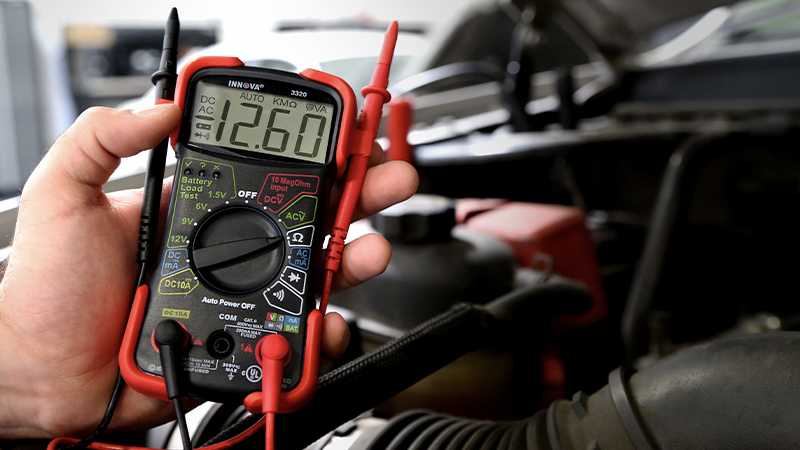Car batteries are essential components to making sure that your vehicle starts and runs reliably, and understanding their lifespan and performing regular tests can extend its lifespan and prevent unexpected breakdowns.
An old battery could be on its way out without even realizing it, which is why conducting an easy home battery test is key to safeguarding its future health and life.
Voltage
Car batteries are designed to operate optimally within a certain voltage range, making regular battery checks vital in ensuring optimal performance. By recording and keeping an eye on battery readings over time, keeping an eye on when their voltage begins to dip can help detect when replacement may become necessary and gives an early warning sign.
An easy way to check your battery voltage is with a multimeter, available online and for around PS10. Simply connect its red lead to the positive terminal while its black cable should go directly into the negative terminal on your battery – any voltage below 12.6 indicates low charge levels which require charging, while any voltage below 12 indicates it may have reached its end of life and you should consider replacement as soon as possible.
For a more accurate evaluation of your battery’s health, measure its voltage during a cranking cycle. This occurs when it is under increased current load from turning over your starter motor, and should show a brief drop in voltage as the starter turns over. Ideally, have it load-tested by professionals; most auto parts stores specialize in batteries offer these services.
Cold Cranking Amps
Cold cranking amps rating (CCA rating) of batteries should be taken into consideration when searching for replacements, as it demonstrates their capacity to deliver current for thirty seconds at zero degrees Fahrenheit or -18 degrees Celsius, while still maintaining terminal voltage above seven point two volts.
Keep in mind, however, that cold cranking amp ratings should only serve as one part of a battery’s capacity and should not be the primary criterion when selecting a car battery. Over time the lead plates in batteries may wear down and reduce their cold cranking amp rating.
Marine Cranking Amps (MCA) rating should also be taken into consideration, particularly in marine environments with temperatures usually above zero degrees Fahrenheit. An MCA battery will have similar testing conditions as CCA batteries but at warmer temperatures – making it more applicable for mild climates than CCA ratings alone.
To assess a battery’s cold cranking amps, connect a multimeter to both positive and negative points on its terminals. Be sure to wear gloves and safety glasses when handling it, as it contains chemicals which could ignite an explosion or fire if exposed directly. It may also help reduce stress on terminals while improving performance by disconnecting it from mounting hardware.
Capacity
Capacity for car batteries is measured in amp-hours or equivalent in Watt-hours (Wh). Understanding your battery’s Ah rating will allow you to accurately gauge how long it can hold its charge, power electric facilities like lights and wipers as well as satellite navigation services if left for extended periods of time without supervision. This knowledge is particularly essential if leaving your vehicle unattended for extended periods.
A standard car battery typically holds 48Ah or 50Amp-hours of energy storage capacity. CCA (cold cranking amps) and reserve capacity should also be considered when selecting your battery.
An easy and accurate way to measure a car battery’s voltage is with a multimeter. Simply switch it onto DC voltage mode and connect its leads to both terminals of your battery – positive and negative terminal. Set up your display so you can read off the voltage reading on it; for an accurate result use a multimeter capable of handling at least 15V for best results.
Life Expectancy
A battery’s lifespan depends on its usage frequency and location. A 10-minute commute every day could leave no opportunity for recharge between trips, leading to its early demise in just three years. Climate can also play an impactful role: extreme heat can destroy battery power while freezing temperatures sap its strength.
Digital multimeters can be an effective tool for monitoring battery health. Available online for around PS10, these digital meters simply connect to battery terminals with their dial set to “volts.” A healthy battery should read 12.7V while anything lower must be replaced immediately.
Conserving car batteries by keeping them inside a garage or covered parking space to shield against sun damage and cold temperatures is one way to extend their lifespan, and turning off functions such as radio or AC while parking reduces strain on their batteries.
Establishing the habit of regularly testing your battery is an ideal way to monitor its health. Testing takes only minutes and could prevent an unexpected breakdown requiring jump starts or replacement batteries from happening suddenly. Furthermore, regular battery tests allow you to plan ahead for when replacement needs to occur.

